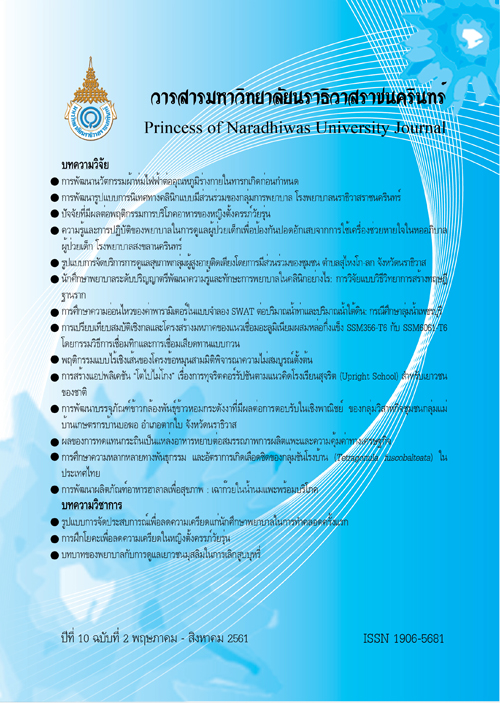Genetic Diversity and Inbreeding Depression of Domestic Group of Stingless Bees (Tetragonula fuscobalteata) in Thailand
Keywords:
Stingless bee, Genetic diversity, Inbreeding coefficient, SSRAbstract
Stingless bees (Tetragonula spp.) are in the same family as honey bees but without a sting. They can be a perfect pollinator in the nature as same as bees. Stingless bee is one of the important insect for the forest ecosystem. The rapid changes of environment are the major impact on population and the way of living of stingless bee in Thailand. Limitation of place for livelihood and decrease in food sources caused the extinction of stingless bee. Therefore, this research aim to study on the genetic diversity and inbreeding
coefficient of domestic group of stingless bees in Thailand. Total 9 beehives of stingless bees were
collected from southern and western of Thailand. Three SSR (Simple Sequence Repeat) primers were used toidentify DNA polymorphism. The results showed that the samples collected from nearby areas of the same
province had closely relationship at 91.97%. Whereas stingless bee from neighboring province Chumphon
and Prachuap Khiri Khan had inbreeding coefficient 45.59%.
References
Cameron, E.C., Franck, P. & Oldroyd, B.P. (2004). Genetic Structure of Nest Aggregations and Drone Congregations of the Southeast Asian Stingless Bee Trigona collina. Molecular Ecology, 13, 2357-2364.
Green, L.C., Franck, P. & Oldroyd, B.P. (2001). Characterization of Microsatellite Loci for Trigona carbonaria, a Stingless Bee Endemic to Australia. Molecular Ecology Notes. DOI: 10.1046/ j.1471-8278.2001.00041.x.
Kalinowski, S.T., Taper, M.L. & Marshall, T.C. (2007). Revising how the computer program CERVUS accommodates genotyping error increases success in paternity assignment. Molecular Ecology, 16, 1099-1106.
Moure, J.S. (1961). A Preliminary Supra Specific Classification of the Old World Meliponine Bees (Hymenoptera
Apidae). Studia Entomologica, 4, 181-242.
Olivier, J., Hardy, J. & Vekemans, X. (2002). Spagedi: a versatile computer program to analyse spatial genetic structure at the individual or population levels. Molecular Ecology Notes, 2, 618-620.
Paxton, J.R., Thoren, P.A., Tengo, J., Estoup, A. & Pamilo, P. (1996). Mating Structure and Nestmate Relatedness in a Communal Bee, Andrena Jacobi (Hymenoptera, Andrenidae), Using Microsatellites. Molecular Ecology, 5, 511-519.
Perrier, X., Flori, A. & Bonnot, F. (2003). Leadership and social exchange process. In Hamon, P., Seguin, M., Perrier, X. & Glaszmann, J.C. (Eds.). Data analysis Methods. pp. 43-76 Genetic Diversity of Cultivated Tropical Plants. Montpellier: Enfield, Science Publishers.
Rasmussen, C. & Cameron, A.S. (2007). A Molecular Phylogeny of the Old World Stingless Bees (Hymenoptera:
Apidae: Meliponini) and the Non-Monophyly of the Large Genus Trigona. Systematic Entomology, 32, 26-39.
Roubik, D.W. (1989). Ecology and Natural History of Tropical Bees. New York, USA: Cambridge University Press.
Ronfort, J., Bataillon, T., Santoni, S., Delalande, M., David, J.L. & Prosperi, J.M. (2006). Microsatellite diversity
and broad scale geographic structure in a model legume: building a set of nested core collection for studying naturally occurring variation in Medicago truncatula. BMC Plant Biology. DOI: 10.1186/1471-2229-6-28.
Schwarz, H.F. (1939). The Indo-Malayan Species of Trigona. Bulletin of The American Museum of Natural History Vol. LXXVI, Art. III, New York, U.S.A.
Tavares, M.G., Dias, L.A., Borges, A.A., Lopes, D.M., Busse, A.H.P. & Costa, R.G., et al. (2007). Genetic divergence between populations of the stingless bee urucu amarela (Melipona rufiventris group, Hymenoptera, Meliponini): Is threr anew Melipona species in the Brazilian state of Minas Gerais?. Genetics and Molecular Biology, 30(3), 667-675.
Theeraapisakkun, M. & Klinbunga, S. (2010). Development of a species-diagnostic marker and its application for population genetics studies of the stingless bee Trigona collina in Thailand. Genetics and Molecular Research, 9(2), 919-930.



